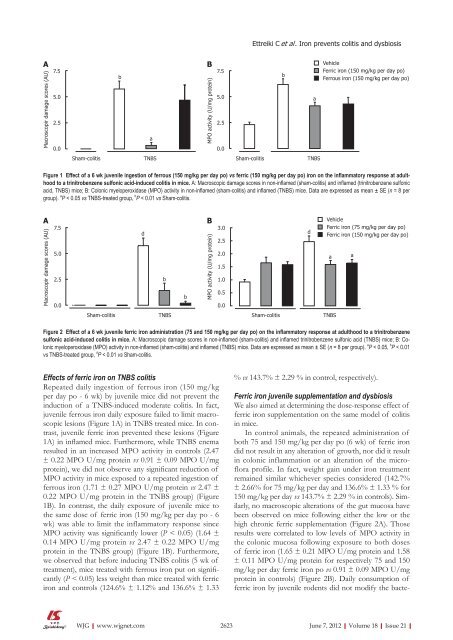Evidence base and patients' perspective - World Journal of ...
Evidence base and patients' perspective - World Journal of ...
Evidence base and patients' perspective - World Journal of ...
Create successful ePaper yourself
Turn your PDF publications into a flip-book with our unique Google optimized e-Paper software.
A<br />
Macroscopir damage scores (AU)<br />
7.5<br />
5.0<br />
2.5<br />
0.0<br />
Sham-colitis TNBS<br />
Figure 1 Effect <strong>of</strong> a 6 wk juvenile ingestion <strong>of</strong> ferrous (150 mg/kg per day po) vs ferric (150 mg/kg per day po) iron on the inflammatory response at adulthood<br />
to a trinitrobenzene sulfonic acid-induced colitis in mice. A: Macroscopic damage scores in non-inflamed (sham-colitis) <strong>and</strong> inflamed (trinitrobenzene sulfonic<br />
acid, TNBS) mice; B: Colonic myeloperoxidase (MPO) activity in non-inflamed (sham-colitis) <strong>and</strong> inflamed (TNBS) mice. Data are expressed as mean ± SE (n = 8 per<br />
group). a P < 0.05 vs TNBS-treated group, b P < 0.01 vs Sham-colitis.<br />
Effects <strong>of</strong> ferric iron on TNBS colitis<br />
Repeated daily ingestion <strong>of</strong> ferrous iron (150 mg/kg<br />
per day po - 6 wk) by juvenile mice did not prevent the<br />
induction <strong>of</strong> a TNBS-induced moderate colitis. In fact,<br />
juvenile ferrous iron daily exposure failed to limit macroscopic<br />
lesions (Figure 1A) in TNBS treated mice. In contrast,<br />
juvenile ferric iron prevented these lesions (Figure<br />
1A) in inflamed mice. Furthermore, while TNBS enema<br />
resulted in an increased MPO activity in controls (2.47<br />
± 0.22 MPO U/mg protein vs 0.91 ± 0.09 MPO U/mg<br />
protein), we did not observe any significant reduction <strong>of</strong><br />
MPO activity in mice exposed to a repeated ingestion <strong>of</strong><br />
ferrous iron (1.71 ± 0.27 MPO U/mg protein vs 2.47 ±<br />
0.22 MPO U/mg protein in the TNBS group) (Figure<br />
1B). In contrast, the daily exposure <strong>of</strong> juvenile mice to<br />
the same dose <strong>of</strong> ferric iron (150 mg/kg per day po - 6<br />
wk) was able to limit the inflammatory response since<br />
MPO activity was significantly lower (P < 0.05) (1.64 ±<br />
0.14 MPO U/mg protein vs 2.47 ± 0.22 MPO U/mg<br />
protein in the TNBS group) (Figure 1B). Furthermore,<br />
we observed that before inducing TNBS colitis (5 wk <strong>of</strong><br />
treatment), mice treated with ferrous iron put on significantly<br />
(P < 0.05) less weight than mice treated with ferric<br />
iron <strong>and</strong> controls (124.6% ± 1.12% <strong>and</strong> 136.6% ± 1.33<br />
WJG|www.wjgnet.com<br />
b<br />
a<br />
7.5<br />
5.0<br />
2.5<br />
0.0<br />
Sham-colitis TNBS<br />
A B Vehicle<br />
Macroscopir damage scores (AU)<br />
7.5<br />
5.0<br />
2.5<br />
0.0<br />
Sham-colitis TNBS<br />
d<br />
b<br />
b<br />
B<br />
MPO activity (U/mg protein)<br />
MPO activity (U/mg protein)<br />
3.0<br />
2.5<br />
2.0<br />
1.5<br />
1.0<br />
0.5<br />
0.0<br />
Ettreiki C et al . Iron prevents colitis <strong>and</strong> dysbiosis<br />
b<br />
Sham-colitis TNBS<br />
% vs 143.7% ± 2.29 % in control, respectively).<br />
a<br />
Vehicle<br />
Ferric iron (150 mg/kg per day po)<br />
Ferrous iron (150 mg/kg per day po)<br />
Ferric iron (75 mg/kg per day po)<br />
Ferric iron (150 mg/kg per day po)<br />
Figure 2 Effect <strong>of</strong> a 6 wk juvenile ferric iron administration (75 <strong>and</strong> 150 mg/kg per day po) on the inflammatory response at adulthood to a trinitrobenzene<br />
sulfonic acid-induced colitis in mice. A: Macroscopic damage scores in non-inflamed (sham-colitis) <strong>and</strong> inflamed trinitrobenzene sulfonic acid (TNBS) mice; B: Colonic<br />
myeloperoxidase (MPO) activity in non-inflamed (sham-colitis) <strong>and</strong> inflamed (TNBS) mice. Data are expressed as mean ± SE (n = 8 per group). a P < 0.05, b P < 0.01<br />
vs TNBS-treated group, d P < 0.01 vs Sham-colitis.<br />
d<br />
Ferric iron juvenile supplementation <strong>and</strong> dysbiosis<br />
We also aimed at determining the dose-response effect <strong>of</strong><br />
ferric iron supplementation on the same model <strong>of</strong> colitis<br />
in mice.<br />
In control animals, the repeated administration <strong>of</strong><br />
both 75 <strong>and</strong> 150 mg/kg per day po (6 wk) <strong>of</strong> ferric iron<br />
did not result in any alteration <strong>of</strong> growth, nor did it result<br />
in colonic inflammation or an alteration <strong>of</strong> the micr<strong>of</strong>lora<br />
pr<strong>of</strong>ile. In fact, weight gain under iron treatment<br />
remained similar whichever species considered (142.7%<br />
± 2.66% for 75 mg/kg per day <strong>and</strong> 136.6% ± 1.33 % for<br />
150 mg/kg per day vs 143.7% ± 2.29 % in controls). Similarly,<br />
no macroscopic alterations <strong>of</strong> the gut mucosa have<br />
been observed on mice following either the low or the<br />
high chronic ferric supplementation (Figure 2A). Those<br />
results were correlated to low levels <strong>of</strong> MPO activity in<br />
the colonic mucosa following exposure to both doses<br />
<strong>of</strong> ferric iron (1.65 ± 0.21 MPO U/mg protein <strong>and</strong> 1.58<br />
± 0.11 MPO U/mg protein for respectively 75 <strong>and</strong> 150<br />
mg/kg per day ferric iron po vs 0.91 ± 0.09 MPO U/mg<br />
protein in controls) (Figure 2B). Daily consumption <strong>of</strong><br />
ferric iron by juvenile rodents did not modify the bacte-<br />
2623 June 7, 2012|Volume 18|Issue 21|<br />
a<br />
a

















